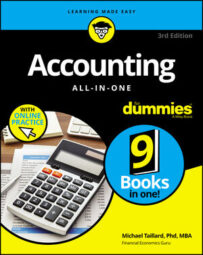Quickly get up to speed on the basics with tips for controlling cash in a business, an overview of cash flow and profit, quick access to essential cost-accounting formulas, and the red flags of financial statement fraud.
4 tips for controlling your business cash
Although bookkeepers typically are the ones who record what happens to your business’s cash, they aren’t the only ones who control where that cash goes. Controlling your company’s money is important: A business’s cash can be a tempting siren for employees who aren’t accountable to the right checks and balances.
Safeguard your company’s money by following these suggestions to limit any one person’s access to cash:
-
Separate cash handlers from recordkeeping. Be sure that the person who accepts cash isn’t also recording the transaction.
-
Separate authorization responsibilities from cash handlers. Be sure that the person who authorizes a payment isn’t also signing the check or dispersing the cash.
-
Segregate the duties of your bookkeeping staff to ensure a good system of checks and balances. Don’t put too much trust in one person — unless that one person is you.
-
Separate operational responsibility (actual day-to-day transactions) from record-keeping responsibility (entering transactions in the books).
The relationship between cash flow and profit
Making profit generates cash flow. Any business owner knows that. But the actual increase in cash during a given period is invariably lower or higher than the profit number. The following points illustrate how cash flow relates to profit:
-
The amounts of cash flows during the period rarely are equal to the revenue and expense numbers in the P&L (profit and loss) report for the period.
-
Actions that lower cash flow: increasing accounts receivable and inventory; decreasing accounts payable and accrued expenses payable.
-
Actions that raise cash flow: decreasing accounts receivable and inventory; increasing accounts payable and accrued expenses payable.
-
Depreciation expense is not a cash outlay in the period recorded; neither is amortization expense; unusual losses recorded in the period may not involve cash outlay but rather be write-downs of assets or write-ups of liabilities.
9 must-know formulas for cost accounting
To reduce and eliminate costs in a business, you need to know the formulas that are most often used in cost accounting. When you understand and use these foundational formulas, you’ll be able to analyze a product’s price and increase profits.
Breakeven Formula:
Profit ($0) = Sales – Variable costs – Fixed costs
Target Net Income:
Target net income = Sales – Variable costs – Fixed costs
Gross Margin:
Gross margin = Sale price – Cost of sales (material and labor)
Contribution Margin:
Contribution margin = Sales – Variable costs
Pre-Tax Dollars Needed for Purchase:
Pre-tax dollars needed for purchase = Cost of item ÷ (1 – Tax rate)
Price Variance:
Price variance = (Actual price – Budgeted price) × (Actual units sold)
Efficiency Variance:
Efficiency variance = (Actual quantity – Budgeted quantity) × (Standard price or rate)
Variable Overhead Variance:
Variable overhead variance = Spending variance + Efficiency variance
Ending Inventory:
Ending inventory = Beginning inventory + Purchases – Cost of sales
13 ways to spot fraud in business financial statements
Financial statement fraud, commonly referred to as “cooking the books,” involves deliberately overstating assets, revenues, and profits and/or understating liabilities, expenses, and losses. When a forensic accountant investigates business financial fraud, she looks for red flags or accounting warning signs that indicate suspect business accounting practices.
These red flags include the following:
-
Aggressive revenue recognition practices, such as recognizing revenue in earlier periods than when the product was sold or the service was delivered
-
Unusually high revenues and low expenses at period end that can’t be attributed to seasonality
-
Growth in inventory that doesn’t match growth in sales
-
Improper capitalization of expenses in excess of industry norms
-
Reported earnings that are positive and growing but operating cash flow that’s declining
-
Growth in revenues that’s far greater than growth in other companies in the same industry or peer group
-
Gross margin or operating margins out of line with peer companies
-
Extensive use of off–balance sheet entities based on relationships that aren’t normal in the industry
-
Sudden increases in gross margin or cash flow as compared with the company’s prior performance and with industry averages
-
Unusual increases in the book value of assets, such as inventory and receivables
-
Disclosure notes so complex that it’s impossible to determine the actual nature of a particular transaction
-
Invoices that go unrecorded in the company’s financial books
-
Loans to executives or other related parties that are written off
A business that engages in such fraudulent practices stands to lose a tremendous amount of money when penalties and fines, legal costs, the loss of investor confidence, and a tarnished reputation are taken into account.

